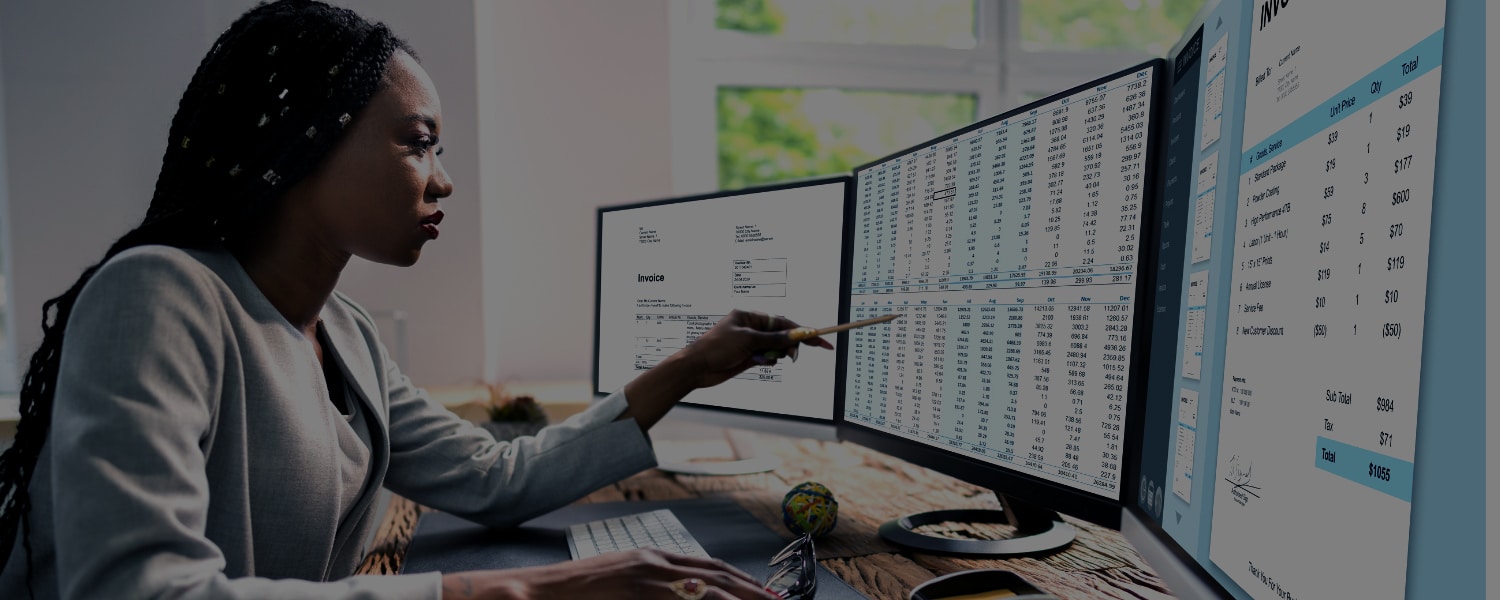
With the help of automation, the inefficiency associated with manual Accounts Payable invoice processing is easily resolved.
It is therefore no surprise that Financial Directors opt for digital transformation solutions in this situation.
In this blog, we will be covering the 5 key reasons why businesses are switching from manual invoicing processing to automated solutions. Highlighting how automation significantly supports the finance department, in particular the Accounts Payable (AP) team.
Automate your Accounts Payable process
Ensure time efficiency, greater accuracy and cost savings with our automated invoicing solution.

The 5 reasons we outline in this blog are as follows…
1. Time efficiency
First of all, manual invoice processing is time-consuming.
One of the key reasons businesses are taking advantage of automation is that it’s a considerably faster process in comparison.
To elaborate, with a manual invoicing process, the AP team rekey data from one source to another. Unsurprisingly, this is not an efficient way of processing inbound invoices.
However, the inefficiency isn’t solely caused by time. Human error (e.g. duplications or incorrect character entry), is also a factor. Approval and payment of these invoices is further delayed as AP teams need to identify and rectify these errors.
As you can imagine, repeating this process for huge volumes of invoice on a data daily, weekly, or monthly basis is extremely inefficient. And only further contributes to a slower approval process.
In fact, according to Ardent Partners’ 2023 research¹, the top AP challenges in 2023, for the second year in a row, are slow invoice and payment approval times (47%).
Unlike paper-based processes, an electronic invoicing system diverts inbound invoices to a cloud-based platform for automated processing.
Thanks to this technology, the risk of human error is eliminated as no rekeying of data between systems is required. Thus, in contrast to a manual process, automated invoice software, such as Transalis AP Automation, ensures a fast exchange of invoices across a trading network and speeds up payments.
2. Greater accuracy
Secondly, only correctly formatted and populated invoices enter your internal systems with an automated invoice system.
As mentioned above, invoicing software is far more accurate than manual invoice processing, as it removes the need for data entry.
Additionally, Transalis’ AP Automation, utilises Intelligent Document Processing (IDP) to ensure accuracy. To elaborate, this technology extracts data from documents such as PDFs and text files, similar to Optical Character Recognition (OCR).
On the other hand, the main difference between IDP and OCR, is that IDP interprets data with AI and Machine Learning (ML). Whilst processing invoice data, IDP makes contextual choices about the content just as a human can, only faster. For instance, it can determine when there are errors and even make corrections.
To explain further, IDP observes the invoices and compares them to the previous formats. Hence, if any changes are identified, a notification is sent of the changes via email, so the AP team can review the adjustment.
Overall, this exceptions tool is far more effective. It prevents the processing of documents with errors, which typically occur with manual processing or solutions reliant on OCR technology alone.
3. Increased productivity
It’s important to be observant of how you are fully utilising your team’s time and to ensure they are directly benefiting the business financially.
There are numerous responsibilities sitting on the AP and AR teams’ shoulders. However, the obligations brought by a manual invoicing process are not necessarily as valuable as other duties they may have. For instance, these are often tedious admin tasks, such as data rekeying.
Alternatively, by switching to an automated invoice system, the team’s workload is immensely reduced. As mentioned above, these solutions take care of administrative tasks by automatically processing data in a faster and more accurate manner. Thus allowing teams to concentrate on higher-value tasks. For example, interacting and building stronger relationships with trading networks and more importantly, revenue-generating activities. Ultimately, turning the accounts team from a cost centre to a profit centre.
4. Environmental benefits
Next, an obvious advantage of switching to an electronic invoice system is the reduction of paper consumption.
Did you know that an average employee approximately prints 450 pages per week? This is according to Adobe², who surveyed over 1500 employees in larger organisations.
The table below illustrates the cost implications of this.
Average annual printed paper consumption per employee
| Pages Printed | REAMS OF PAPER | BOXES OF PAPER | TOTAL PAPER COST |
|---|---|---|---|
| 23,400 | 47 | 5 | £200 |
(based on an average cost for a box of paper – 10 reams, of £40)
Hence, when these calculations are scaled up across the whole organisation, or even just across an entire team, the cost implications are clear.
However, the table above only takes into consideration the cost of paper. Thus, there are other factors, such as ink and the running of printing hardware, that also need to be taken into account. Overall, Gartner³ estimates that printing cost in fact costs businesses between 1-3% of their annual revenue.
As a result, businesses are now embracing digital transformation. A paper-to-digital approach, such as AP Automation, significantly diminishes paper consumption and thus cuts business spend.
Of course, there is also the CSR aspect of taking an environmentally friendly approach. As outlined in a report by Forrester, 58% of European consumers prefer to purchase more environmentally friendly products.⁴ Thus, reducing one’s carbon footprint is becoming more and more necessary to ensure a positive public brand identity.
5. Reducing costs
In addition, automating the invoicing process can deliver great financial benefits.
An automated Accounts Payable invoicing process can provide a great ROI. According to Billentis⁵, businesses can achieve between 60% to 80% savings compared to the labour-intensive manual process.
Furthermore, with our eInvoice solution, businesses that receive more than 2000 invoice documents per month can see an ROI of up to 80%, over manual Accounts Payable invoice processing.
We also understand the importance of price transparency. With our AP Automation solution, you can calculate your precise cost savings using our calculator.
Bonus electronic invoicing software benefits…
In addition to those highlighted, there are more benefits to switching to automated Accounts Payable invoice processing.
Real-time visibility of processing status
Reduction in DSO (Days Sales Outstanding)
Better security, through protections such as encrypted file transfer, safer exchange networks and digital signatures
Easier analysis of data to inform decisions on finance and procurement
Better engagement with trading partners who also use eInvoicing
Can be operated by teams working remotely
No risk of invoices being ‘lost in the post’ or ending up in spam folders
eInvoice Software
Reap the benefits of an automated Accounts Payable invoice processing system by implementing our eInvoice solution. Alternatively, you can contact our friendly team at 0845 123 3746 (UK callers) or +44 1978 369 343 (international callers), or email us via sales@transalis.com.
References:
¹Ardent Partner. 2023. Ardent Partners’ Accounts Payable Metrics that Matter in 2023.
²Adobe. 2022. Time, money and environmental impact: the true cost of unsustainable working.
³Gartner. 2019. Forecast: Enterprise Print Spending, Worldwide, 2017-2023, 3Q19 Update.
⁴Forrester. 2022. European Predictions 2023: Highlights.
⁵Billentis. 2019. The e-invoicing journey 2019-2025








